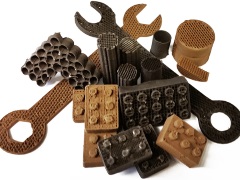Features
Where no bioplastic has gone before
Date: 2017-04-28 11:44:52.0
Author: Jon Evans

Some of the tools and building blocks that
Ramille Shar and her colleagues made by
3D printing with lunar and Martian dust.
Image: Northwestern University.
As a bioplastic, polylactic acid (PLA) has many advantages. It has physical properties similar to widely used traditional plastics such as polystyrene and polyethylene terephthalate; it’s biodegradable, unlike other bioplastics; and it’s a thermoplastic, which has led it to become one of the most popular plastic materials for 3D printing (see Sweet smell of 3D printing). Even for applications where PLA isn’t naturally suitable, a slight bit of modification can often do the trick, and that has recently taken PLA to some surprising new places.
One of those places is inside electronic devices, where conventional plastics such as acrylonitrile butadiene styrene (ABS) currently hold sway. The growing prevalence of electronic devices such as tablet computers and mobile phones, and the increased speed at which they are being replaced, is leading to a big rise in electrical waste, with around 42 million tonnes produced globally in 2014.
If ABS and other non-biodegradable plastics were replaced with biodegradable bioplastics such as PLA, this electronic waste would be much easier to deal with and dispose of. But the problem is that PLA is too brittle and flammable for use in electronic devices, and doesn’t possess the right electrical properties. One potential solution involves incorporating additives into PLA to alter its physical and electrical properties, and that is what Xinlong Wang and his colleagues at Nanjing University of Science & Technology in China have now done with a metal-organic framework (MOF) known as ZIF-8.
MOFs are three-dimensional, crystalline materials in which metal-containing molecules acting as ‘joints’ are linked together by long, rigid organic groups acting as ‘struts’. Wang and his colleagues chose to use them as additives because previous research has shown that the organic ‘struts’ bind strongly with polymers, allowing them to have a major effect on a polymer’s physical properties.
Mixing PLA with varying concentrations of ZIF-8 produced several different nanocomposites, which Wang and his colleagues then tested. As they report in a paper in Industrial & Engineering Chemistry Research, thin films of these nanocomposites were less brittle and flammable than pure PLA, but were just as transparent and possessed superior electrical properties, making them ideal for use in electronic devices. A nanocomposite containing 1% of ZIF-8 by weight possessed the single best mix of properties.
Ramille Shah and her colleagues at Northwestern University in Illinois, US, have combined a PLA-based biopolymer with even more exotic materials: the crushed rock known as regolith that covers the surface of the Moon and Mars. Because real regolith is rather hard to obtain, they actually used simulated lunar and Martian regolith produced by Nasa. Their reason for doing this was not to improve the physical properties of the PLA-based biopolymer, but to produce a material that can be 3D printed on the Moon and Mars.
Future colonists on these and other planetary bodies are going to need to produce the vast majority of everything they need from the materials around them, as it will be impractical to keep sending supplies from Earth. So Shah and her colleagues set about developing a way to produce a printable material from the regolith simulants, based on a previous method they’d developed for producing 3D printable inks from materials such as ceramics and graphene. This involved first sieving each regolith simulant to remove the larger particles, and then combining them with the biopolymer polylactide-co-glycolide (PLGA) and a mixture of two solvents and a plasticizer.
Despite comprising 90% regolith, the resultant ink had sufficient consistency for 3D printing, hardening quickly after printing, as the solvents evaporated away, to produce a flexible material like rubber. As Shah and her team report in Scientific Reports, they were able to print a variety of items with their regolith ink, including cylinders and wrenches.
"We even 3D-printed interlocking bricks, similar to Legos, that can be used as building blocks," she said.
The great advantage of this ink is that all its components can either be derived from readily available sources or recycled from previously printed items. The lactic acid and glycolic acid that are the building blocks of PLGA, for example, could be derived from the compost and urine produced by the human colonists. With some MOFs as well, the colonists could even keep up to date with the latest mobile phones.
The views represented here are solely those of the author and do not necessarily represent those of John Wiley and Sons, Ltd. or of the SCI.
Displaying 13 keywords used to tag this article:
- Roger Vivier Ankle Bootie Suede Bla
- Replica Omega Constellation 123.50.
- Timberland Stövlar | Rabatt Timber
- Replica Omega Speedmaster 321.32.44
- louis männer flach im pazifischen
- Timberland Chukka Mens Boots Chestn
- Shoulder Bags
- Rolex New Replica Watch Automatic M
- Replica Patek Philippe
- populära Moncler Nytt 2012 med lå
- Montblanc Meisterstuck Le Grand Rol
- Hermes Kelly Bolsas
- Buy Your Fashionable Fake Omega Wat
